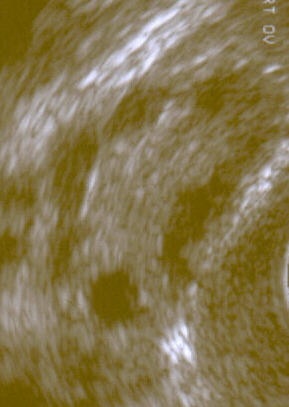
The Case of Lindsay Harnish
last authored: July 2010, Kim Colangelo
last reviewed:
A 27 year old nulliparous female, Mrs. H., presents to her family doctor because her and her husband have been trying to get pregnant for the last 8 months with no success. She has had no change in her medical conditions and no major illnesses recently, she has never had surgery before. She is employed as a receptionist for a law firm and her husband is an engineer.
Does this situation meet the definition for infertility?
- a.Yes, because she has never been pregnant before
- b.Yes, because she has never been pregnant and they have been trying for more than 6 months
- c.No, because they have not been trying for more than a year
- d.No, because you don’t know if she is ovulating
Answer (hover over here for 2 seconds)
On review of systems she is an obese woman with no cardiac, respiratory, renal, gastrointestinal or neurologic symptoms. She is not sensitive to temperature. She has a past history of Chlamydia treated with antibiotics but has infrequent pelvic exams. She has recurrent pelvic pain that has never been diagnosed. Her periods have always been irregular. On social history she is a non-smoker, rare ethanol consumer, non recreational drug user. She is a receptionist and has had significant stress over the last 2 years as her mother has been very ill.
Based on the history, what are the top three things on your differential diagnosis as a cause for her difficulty conceiving?
Answer (click)
You explain to the patient that 85% of couples achieve conception within a year of trying and 90% within two years. Her stress could play a role and you advise her to try some relaxation techniques and follow up with you in 4 months. She returns 4 months later frustrated that she is still not pregnant. You decide to do a thorough history and physical. The history is unchanged from above. On physical exam you note that her BMI is 35. Screening cardiovascular, respiratory, neurological, MSK are normal. On abdominal exam you see a significant amount of hair, and when you mention it she says she has to wax her chin frequently.
What is another sign that would fit with the suspected syndrome?
- a. Bloating
- b. Acne
- c. Biliary colic
- d. Low back pain
Answer (hover over)
You order a pelvic ultrasound, which reveals the following:

What type of image is this? What is the significant finding?
Answer (hover over)
You are now highly suspicious that she has polycystic ovarian syndrome (PCOS), and this could be contributing to her difficulty conceiving. Another name for PCOS is Stein-Leventhal syndrome, after its discoverers. You have now done a thorough history, physical, and ultrasound and are debating what bloodwork and other tests to do.
What other investigations would you like to order?
Answer (click)
You explain your findings to Mrs. Harnish. She is very upset and asks you why this has happened.
What is the pathophysiology of PCOS?
- a. An abnormality in the metabolism of hormones such as androgens and estrogens, and over-production of androgens with insulin resistance playing a role
- b. Hereditary dyslipidemia that directly causes the ovaries to become cystic, thus stimulating the ovaries to produce elevated estrogen levels
- c. Exogenous androgen intake that stimulates endogenous androgen production and has a negative feedback role on estrogen levels
- d. An autosomal recessive disorder characterized by a deficiency in 21-hydroxylase leading to cortisol insufficiency.
Answer (hover over)
After understanding the mechanism for her syndrome, Mrs. Harnish wants to know what can be done to help her conceive. You explain that treatment for PCOS involves lifestyle modifications, pharmacological treatments, and occasionally surgical treatment. The exact plan will depend on the goal of treatment.
Name 3 medications that may be used to treat PCOS or it’s side effects.
- a. OCP, clomiphene citrate, spironolactone
- b. OCP, bromocriptine, calcium
- c. OCP, dalteparin, metoclopramide
- d. OCP, omeprazole, furosemide
Answer (hover over)
In addition to medications, what lifestyle modifications and non-pharmacological treatment may be started?
Answer (click)
